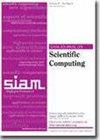等级结构矩阵的线性复杂性黑盒随机压缩
IF 2.6
2区 数学
Q1 MATHEMATICS, APPLIED
引用次数: 0
摘要
SIAM 科学计算期刊》,第 46 卷第 3 期,第 A1747-A1763 页,2024 年 6 月。 摘要。本文提出了一种计算给定秩结构矩阵[math]压缩表示的随机算法。该算法仅通过其对向量的作用与[math]交互。具体来说,它从一个合适的分布中抽取两个高瘦矩阵[math],然后根据集合[math]中包含的信息重建[math]。对于块级[math]的 "分层块可分离(HBS)"矩阵(又称分层半可分离矩阵)的特定情况,所需的样本[math]数满足[math],其中[math]具有代表性。虽然以前发表过很多压缩秩结构矩阵的随机算法,但目前的算法似乎是第一个既具有真正线性复杂度(复杂度约束中没有[math]因子),又完全 "黑箱"(不需要矩阵条目评估)的算法。此外,所有样本都可以并行提取,使算法可以在 "流 "或 "单视图 "模式下工作。本文章由计算机程序翻译,如有差异,请以英文原文为准。
Linear-Complexity Black-Box Randomized Compression of Rank-Structured Matrices
SIAM Journal on Scientific Computing, Volume 46, Issue 3, Page A1747-A1763, June 2024.
Abstract. A randomized algorithm for computing a compressed representation of a given rank-structured matrix [math] is presented. The algorithm interacts with [math] only through its action on vectors. Specifically, it draws two tall thin matrices [math] from a suitable distribution, and then reconstructs [math] from the information contained in the set [math]. For the specific case of a “Hierarchically Block Separable (HBS)” matrix (a.k.a. Hierarchically Semi-Separable matrix) of block rank [math], the number of samples [math] required satisfies [math], with [math] being representative. While a number of randomized algorithms for compressing rank-structured matrices have previously been published, the current algorithm appears to be the first that is both of truly linear complexity (no [math] factors in the complexity bound) and fully “black box” in the sense that no matrix entry evaluation is required. Further, all samples can be extracted in parallel, enabling the algorithm to work in a “streaming” or “single view” mode.
Abstract. A randomized algorithm for computing a compressed representation of a given rank-structured matrix [math] is presented. The algorithm interacts with [math] only through its action on vectors. Specifically, it draws two tall thin matrices [math] from a suitable distribution, and then reconstructs [math] from the information contained in the set [math]. For the specific case of a “Hierarchically Block Separable (HBS)” matrix (a.k.a. Hierarchically Semi-Separable matrix) of block rank [math], the number of samples [math] required satisfies [math], with [math] being representative. While a number of randomized algorithms for compressing rank-structured matrices have previously been published, the current algorithm appears to be the first that is both of truly linear complexity (no [math] factors in the complexity bound) and fully “black box” in the sense that no matrix entry evaluation is required. Further, all samples can be extracted in parallel, enabling the algorithm to work in a “streaming” or “single view” mode.
求助全文
通过发布文献求助,成功后即可免费获取论文全文。
去求助
来源期刊
CiteScore
5.50
自引率
3.20%
发文量
209
审稿时长
1 months
期刊介绍:
The purpose of SIAM Journal on Scientific Computing (SISC) is to advance computational methods for solving scientific and engineering problems.
SISC papers are classified into three categories:
1. Methods and Algorithms for Scientific Computing: Papers in this category may include theoretical analysis, provided that the relevance to applications in science and engineering is demonstrated. They should contain meaningful computational results and theoretical results or strong heuristics supporting the performance of new algorithms.
2. Computational Methods in Science and Engineering: Papers in this section will typically describe novel methodologies for solving a specific problem in computational science or engineering. They should contain enough information about the application to orient other computational scientists but should omit details of interest mainly to the applications specialist.
3. Software and High-Performance Computing: Papers in this category should concern the novel design and development of computational methods and high-quality software, parallel algorithms, high-performance computing issues, new architectures, data analysis, or visualization. The primary focus should be on computational methods that have potentially large impact for an important class of scientific or engineering problems.

 求助内容:
求助内容: 应助结果提醒方式:
应助结果提醒方式:


